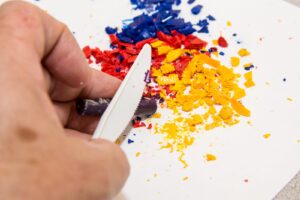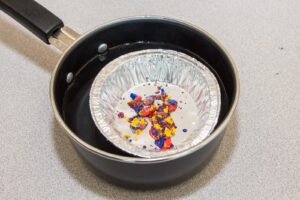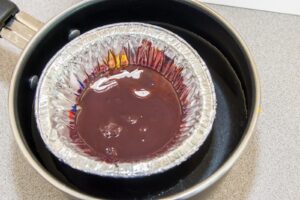The phrases “solid as a rock,” “written in stone,” and “between a rock and a hard place” all evoke images of rocks as permanent and unchanging. But the truth is, nothing lasts forever. Rocks do change, but it can take a long time. It is difficult for humans to think of time on a geological scale, where 1 million years is but the blink of an eye. But to a rock, that’s exactly how time works. The rocks on our planet are constantly changing, although we may not be able to witness it on a daily basis. Don’t despair, though! There is an easy and fun way to model how rocks change over time with your curious little ones.
Materials to Collect:
- Crayons (any old, broken, neglected crayons of any size or color will work for this. In fact, the more diverse they are, the better!)
- Aluminum foil squares (about 3–4”), or foil cupcake wrappers
- Popsicle sticks
- Plastic knife or cheese grater
- Hot water
- Pan for hot water
Step 1: Making the Rocks
 Tell your little geologist that the crayons are going to be our rocks. Ask them what would happen to our “rocks” if they got rubbed together, tumbled down a hill, or if the wind blew over them for a very long time. They may say that the crayons will break apart. Provide a few rocks for your child to rub together to see what will happen. Sandstone works well for this and is plentiful in Connecticut. Have your geologist use a plastic knife, or even a cheese grater, to shave or break a few crayons into small pieces.
Tell your little geologist that the crayons are going to be our rocks. Ask them what would happen to our “rocks” if they got rubbed together, tumbled down a hill, or if the wind blew over them for a very long time. They may say that the crayons will break apart. Provide a few rocks for your child to rub together to see what will happen. Sandstone works well for this and is plentiful in Connecticut. Have your geologist use a plastic knife, or even a cheese grater, to shave or break a few crayons into small pieces.
Step 2: Sedimentary Rock
Ask your  scientist what would happen if more and more pieces were stacked on top of one another. What would the pieces on the bottom feel? Answer: they would feel a lot of weight!
scientist what would happen if more and more pieces were stacked on top of one another. What would the pieces on the bottom feel? Answer: they would feel a lot of weight!
To simulate this, place the crayons between two sheets of aluminum foil and have your scientist press them together or step on foil with their foot. Or, get creative and place a couple of books or other heavy, flat items on the crayon shavings and sit or step on them. After a little while, take the crayons out and examine them. They should be pressed together into one somewhat delicate piece. You have just modeled sedimentary rock!
Explanation: As small pieces of rock break off, they may be carried by wind or water and deposited together in a new location. As more new sediment is added, the sediment below may become cemented together by pressure and usually the addition of water. This creates sedimentary rock. Sandstone, limestone, gypsum, and conglomerate are examples of sedimentary rocks.
Step 3: Metamorphic Rock
N ext, take your sedimentary rock, and ask what would happen if the rock was pushed deep underground. What would it feel? Answer: it would feel heat and pressure. Place your sedimentary rock in a foil cupcake wrapper or piece of aluminum foil molded into a cup shape. Float the wrapper or foil in some warm, but not too hot, water until it starts to get soft. Do not let it melt all the way! Use a popsicle stick to test and see when it is soft. Ask your little geologist if they can see the original crayons that were in the sedimentary rock. They should still see the original colors from the sedimentary rock in their new rock. They have just made metamorphic rock!
ext, take your sedimentary rock, and ask what would happen if the rock was pushed deep underground. What would it feel? Answer: it would feel heat and pressure. Place your sedimentary rock in a foil cupcake wrapper or piece of aluminum foil molded into a cup shape. Float the wrapper or foil in some warm, but not too hot, water until it starts to get soft. Do not let it melt all the way! Use a popsicle stick to test and see when it is soft. Ask your little geologist if they can see the original crayons that were in the sedimentary rock. They should still see the original colors from the sedimentary rock in their new rock. They have just made metamorphic rock!
Explanation: As rock gets pushed down into the earth’s crust, pressure and temperature increase. This causes the rock to become soft and flow like plastic. The rock then changes due to the heat and pressure; this is called metamorphosis. Thus, we have metamorphic rock. Slate, marble, and soapstone are examples of metamorphic rock.
Step 4: Igneous Rock

Now, ask what would happen if your metamorphic rock got pushed even deeper into the earth. The answer: it would melt! Take your muffin wrapper or foil and put it back into the hot water or on a hot plate and let it melt all the way. When it’s melted, take it out and let it cool; placing it in cold water or the freezer will speed up the process. You now have igneous rock!
Explanation: When rock melts completely it becomes magma (if it’s underground) or lava (if it’s above ground). Once it cools it becomes solid igneous rock. Whether it cools underground or above, and how slowly or quickly it cools, affects what kind of igneous rock it becomes. Obsidian, pumice, basalt, and granite are examples of igneous rock.
More to Explore:
Challenge your budding geologist, after you have modeled all three types of rocks, to make them in a different order. Can they explain how a metamorphic rock might become sedimentary? Or how a sedimentary rock might become igneous? The rock cycle can occur in any order, and rocks will continuously change state, albeit very slowly, for as long as there is an Earth.

Andrew Fotta is a STEM educator at the Connecticut Science Center. He has currently holds a CT teaching certification for grades K-6, and has spent time in the classroom in nearly all grades, and taught middle school science. In addition to teaching classes for the Science Center, Andrew is also part of a team of educators currently creating new programs aligned with the new Next Generation Science Standards for grades PreK-9. Andrew is an avid photographer, who enjoys blending science and art in his work.


